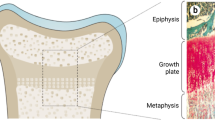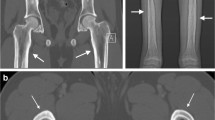Abstract
Purpose
Adolescent idiopathic scoliosis (AIS) is believed to be caused by genetic, neurological, osseous growth anomalies, histological variables including muscle fiber percentage and core structure changes, metabolic and hormonal dysfunction, vestibular dysfunction, and platelet microarchitecture. The objective of this study was to contribute to the determination of the cause of AIS by analyzing the changes in pineal gland volume in AIS cases.
Methods
Study (AIS) and control group were each comprised of 26 patients who met the inclusion requirements. Scoliosis radiograph and MRI of the pineal glands were used for radiological examinations. The distribution of age, gender, Risser grading for skeletal radiological development, and sexual maturation according to Tanner categorization were uniform and statistically insignificant between groups.
Results
When the pineal gland volumes of the cases were evaluated according to age, the AIS group was found to have significantly reduced pineal gland volumes in all age groups. The pineal gland volume was found to be 38.1% lower in the AIS group compared to the control group (p˂0.001). In the AIS group, patients aged 13 years had the lowest pineal gland volume (77.2 ± 13.86 mm3), while patients aged 15 years had the highest volume (97.9 ± 16.47 mm3).
Conclusion
Changes in pineal gland volume support the role of the pineal gland in the etiopathogenesis of AIS.






Similar content being viewed by others
References
Suh KT, Lee SS, Kim SJ, Kim YK, Lee JS (2007) Pineal gland metabolism in patients with adolescent idiopathic scoliosis. J Bone Jt Surg - Ser B 89(1):66–71
Vasiliadis ES, Grivas TB, Kaspiris A (2009) Historical overview of spinal deformities in ancient Greece. Scoliosis 4:6
Wai MGC, Jun WWW, Yee YAP, Ho WJ, Bun NT, Ping LT et al (2014) A review of pinealectomy-induced melatonin-deficient animal models for the study of etiopathogenesis of adolescent idiopathic scoliosis. Int J Mol Sci 15(9):16484–16499
Patten SA, Moldovan F (2011) Could genetic determinants of inner ear anomalies be a factor for the development of idiopathic scoliosis? Med Hypotheses 76(3):438–440
Gaudreault N, Arsenault AB, Larivière C, DeSerres SJ, Rivard C-H (2005) Assessment of the paraspinal muscles of subjects presenting an idiopathic scoliosis: an EMG pilot study. BMC Musculoskelet Disord 6:14
Cheung KMC, Lu DS, Poon AMS, Wang T, Luk KDK, Leong JCY (2003) Effect of melatonin suppression on scoliosis development in chickens by either constant light or surgical pinealectomy. Spine 28:1941–1944
Machida M, Dubousset J, Yamada T, Kimura J, Saito M, Shiraishi T et al (2006) Experimental scoliosis in melatonin-deficient C57BL/6J mice without pinealectomy. J Pineal Res 41(1):1–7
Machida M, Dubousset J, Imamura Y, Miyashita Y, Yamada T, Melatonin KJ (1996) A possible role in pathogenesis of adolescent idiopathic scoliosis. Spine 21(10):1147–1152
Sigurdardottir LG, Markt SC, Sigurdsson S, Aspelund T, Fall K, Schernhammer E et al (2016) Pineal gland volume assessed by MRI and Its correlation with 6-Sulfatoxymelatonin levels among older men. J Biol Rhythms 31(5):461–469
Machida M, Saito M, Dubousset J, Yamada T, Kimura J, Shibasaki K (2005) Pathological mechanism of idiopathic scoliosis: experimental scoliosis in pinealectomized rats. Eur spine J Off Publ Eur Spine Soc Eur Spinal Deform Soc Eur Sect Cerv Spine Res Soc 14(9):843–848
Kono H, Machida M, Saito M, Nishiwaki Y, Kato H, Hosogane N et al (2011) Mechanism of osteoporosis in adolescent idiopathic scoliosis: experimental scoliosis in pinealectomized chickens. J Pineal Res 51(4):387–393
Grivas TB, Savvidou OD (2007) Melatonin the “light of night” in human biology and adolescent idiopathic scoliosis. Scoliosis 2:6
Machida M, Dubousset J, Yamada T, Kimura J (2009) Serum melatonin levels in adolescent idiopathic scoliosis prediction and prevention for curve progression–a prospective study. J Pineal Res 46(3):344–348
Aota Y, Terayama H, Saito T, Itoh M (2013) Pinealectomy in a broiler chicken model impairs endochondral ossification and induces rapid cancellous bone loss. Spine J [Internet]. 13(11):1607–1616. https://doi.org/10.1016/j.spinee.2013.05.017
THILLARD MJ (1959) [Vertebral column deformities following epiphysectomy in the chick]. C R Hebd Seances Acad Sci. 248(8):1238–40.
Machida M, Dubousset J, Imamura Y, Iwaya T, Yamada T, Kimura J (1995) Role of melatonin deficiency in the development of scoliosis in pinealectomised chickens. J Bone Joint Surg Br 77(1):134–138
Bagnall K, Raso VJ, Moreau M, Mahood J, Wang X, Zhao J (1999) The effects of melatonin therapy on the development of scoliosis after pinealectomy in the chicken. J Bone Joint Surg Am 81(2):191–199
Fagan AB, Kennaway DJ, Oakley AP (2009) Pinealectomy in the chicken: a good model of scoliosis? Eur spine J Off Publ Eur Spine Soc Eur Spinal Deform Soc Eur Sect Cerv Spine Res Soc 18(8):1154–1159
Cheung KMC, Wang T, Poon AMS, Carl A, Tranmer B, Hu Y et al (2005) The effect of pinealectomy on scoliosis development in young nonhuman primates. Spine 30(18):2009–2013
Machida M, Murai I, Miyashita Y, Dubousset J, Yamada T, Kimura J (1999) Pathogenesis of idiopathic scoliosis Experimental study in rats. Spine 24(19):1985–1989
Fjelldal PG, Grotmol S, Kryvi H, Gjerdet NR, Taranger GL, Hansen T et al (2004) Pinealectomy induces malformation of the spine and reduces the mechanical strength of the vertebrae in Atlantic salmon. Salmo salar J Pineal Res 36(2):132–139
Kouwenhoven J-WM, Castelein RM (2008) The pathogenesis of adolescent idiopathic scoliosis: review of the literature. Spine 33(26):2898–2908
Emet M, Ozcan H, Ozel L, Yayla M, Halici Z, Hacimuftuoglu A (2016) A review of melatonin, its receptors and drugs. Eurasian J Med 48(2):135–141
Görgülü FF, Koç AS (2021) Is there any relationship between autism and pineal gland volume? Polish J Radiol 86:e225–e231
Murata J, Sawamura Y, Ikeda J, Hashimoto S, Honma K (1998) Twenty-four hour rhythm of melatonin in patients with a history of pineal and/or hypothalamo-neurohypophyseal germinoma. J Pineal Res 25(3):159–166
Gheban B-A, Colosi HA, Gheban-Rosca I-A, Pop B, Domșa A-MT, Georgiu C, et al. 2021 Age-related changes of the pineal gland in humans: a digital anatomo-histological morphometric study on autopsy cases with comparison to predigital-Era Studies. Medicina (Kaunas). 57(4).
Golan J, Torres K, Staśkiewicz GJ, Opielak G, Maciejewski R (2002) Morphometric parameters of the human pineal gland in relation to age, body weight and height. Folia Morphol (Warsz) 61(2):111–113
Funding
This study was not funded by any commissions of public, commercial, or not-for-profit sectors for the conduct of research, study design, and collection, analysis, and interpretation of the data writing the report, and/or decision of the article for publication.
Author information
Authors and Affiliations
Corresponding author
Ethics declarations
Conflict of interest
The authors have no conflict of interest to declare.
Ethical approval
The study protocol was approved by the local Clinical Research Ethics Committee numbered 2021/538. All procedures were performed in the Kayseri City Education and Research Hospital, Kayseri, Turkey.
Informed consent
Written informed consent was obtained from each patient. The study was conducted in accordance with the principles of the Declaration of Helsinki.
Additional information
Publisher's Note
Springer Nature remains neutral with regard to jurisdictional claims in published maps and institutional affiliations.
Rights and permissions
Springer Nature or its licensor (e.g. a society or other partner) holds exclusive rights to this article under a publishing agreement with the author(s) or other rightsholder(s); author self-archiving of the accepted manuscript version of this article is solely governed by the terms of such publishing agreement and applicable law.
About this article
Cite this article
Batın, S., Ekinci, Y., Gürbüz, K. et al. The role of pineal gland volume in the development of scoliosis. Eur Spine J 32, 181–189 (2023). https://doi.org/10.1007/s00586-022-07452-z
Received:
Revised:
Accepted:
Published:
Issue Date:
DOI: https://doi.org/10.1007/s00586-022-07452-z




